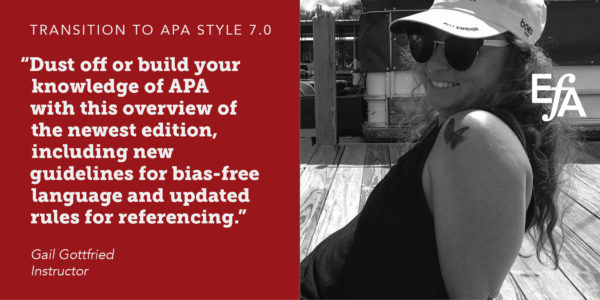Description

Are you a CMoS expert who passes on opportunities that require APA style? Or maybe you accept APA-style projects on occasion and find yourself (cursing and) paging through the manual. This webinar is designed to open some new doors for your business. Perhaps you’ve worked with this style in the past and want a summary of the important updates to the Publication Manual of the American Psychological Association. We’re covering that, too.
APA style isn’t just about how many spaces go after periods (one), name/date referencing format (now reduced to et al. in all but a few circumstances), and hanging indents. It’s really about making things easier for the reader. For example, the newly published guidelines for reducing bias and for clarity and cohesiveness were developed for contemporary audiences, based on research in psychology and the learning sciences, and are applicable for all editorial work regardless of how references are formatted.
This webinar is designed to provide an overall introduction to the guidelines in the newly published seventh edition of the Publication Manual as well as a closer look into the grammar and style features that are expected when editing to follow APA style. We will address some of the big-picture content guidelines, such as when to use identify-first language rather than person-first language, as well as some of the smaller details that distinguish APA style from CMoS. We will also review how to query and correct some of the common problems to look for when editing for academic authors, such as anthropomorphism, wordiness and redundancy, and misplaced modifiers. Finally, we will cover reliable online sources to consult when you’re unsure.
Instructor Gail Gottfried, PhD, is a psychology professor whose experience with APA style dates back to the second edition of the Publication Manual. Her clients include the big publishing houses, research organizations, students and faculty, and the American Psychological Association, who recently paid her the highest compliment: “You have an excellent grasp of APA Style, and you often capture points of editing that others frequently miss.”



